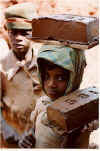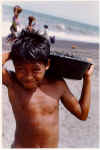 Children for Hire
Children for Hire
October 1998 IBEW Journal
Part I
Workers in North America have taken their lumps from changes brought
about by competition from other nations. What exactly are some of
the effects of this so-called "global economy," and against
whom exactly are Canadian and American workers competing?
It is sad and horrifying to say that the "competition"
often consists of children, some below the age of 10, laboring at
dirty, dangerous jobs. It is even worse to consider that many North
American workers may unwittingly contribute to this shame by purchasing
products made by the sweat of these little brows. Child labor is
more than an abstract problem in some far off corner of the world.
It is a human disgrace, one that has an impact close to home.
"Nearly a quarter of the world’s children between the
ages of 5 and 14 are working full- or part-time, with as many as
two-thirds of the total in hazardous conditions," reports the
International Labour Organization (ILO), Geneva, in a recent press
release. "A majority of working children are found in developing
countries, where children work full- or part-time in horrendous
conditions. In such countries alone, there are at least 120 million
children, 5 to 14 years of age, fully at work and more than twice
as many (about 250 million), for whom work is a secondary activity.
Of these, 61 percent, or 153 million of them, are in Asia; 32 percent,
or 80 million, are in Africa; and 7 percent or 17.5 million, are
in Latin America.
It is estimated that there are 25,000 soccer ball stitchers in
the city of Sialkot, Pakistan, which makes 80 percent of the world’s
soccer balls. The children stitch 2-3 balls a day, receiving around
25 cents per ball, which are sold in the United States for approximately
$50. Some of the other "occupations" include "stone
breakers"—little children and their families who make
a living by smashing rocks into fine gravel for use in the building
industry in Zambia-Lukasa, Africa. One would find an eight-year-old
boy, from Mandala Village, India, working in the vast brick fields,
north of the capital, New Delhi. Children in Sivakasi, India, make
tubes for the fireworks industry. In Bogota, Columbia, young boys
collect scrap cardboard and paper in the streets of the Colombian
capitol for recycling.
 Children
such as these are particularly vulnerable (under 12 years of age).
They are expected to lift heavy loads, such as heavy masonry bricks,
and have no protection from toxic chemicals, sharp tools, motorized
equipment and extreme weather exposure. They are also at risk from
poor nutrition, tobacco and drug addiction, delinquency and even
prostitution. Children
such as these are particularly vulnerable (under 12 years of age).
They are expected to lift heavy loads, such as heavy masonry bricks,
and have no protection from toxic chemicals, sharp tools, motorized
equipment and extreme weather exposure. They are also at risk from
poor nutrition, tobacco and drug addiction, delinquency and even
prostitution.
Working children are also found in other industrialized economies,
including Italy, Portugal and the United Kingdom. In Eastern and
Central Europe, child labor has been reappearing in the wake of
social and economic dislocation caused by the transition to a market
economy. These children face dangerous conditions (even by adult
standards) in construction, mining and quarrying. In the construction
industry, 26 percent of working children sustained injuries, illnesses
or death while on the job; in the mining and quarry sector, 16 percent;
in the transport/storage/communications industries, 18 percent;
and in agriculture, 12 percent.
Child labor was given a face and a name several years ago when
a brave 12-year-old laborer/activist, Iqbal Masih, from Pakistan
began a campaign to expose conditions facing children working in
the carpet industry in that nation. He was brutally murdered for
his courage. However, his death provoked a world-wide uproar and
resulted in union-led boycotts in the United States and pressure
on governments, manufacturers and importers to end child labor,
as well as the establishment and enforcement of the RUGMARK
label on imported rugs, which identified carpets made without
child labor.
Made in America—By Children
When most Americans think of child labor, they probably recall
images of children working in coal mines and textile mills in the
late 19th or early 20th century. Surely, such things don’t
exist on this continent anymore. It does.
A five-month Associated Press (AP) investigation of child labor
in America detailed the abuses they found. Over this period, the
AP found 165 children working illegally in 16 states in the U.S.,
from the chili fields of New Mexico to the sweatshops of New York
City. The investigation was difficult because these children are
part of the "secret workers" hidden from public view.
To make an estimate, the AP had Rutgers University labor economist,
Douglas Kruse, analyze monthly census surveys and other information
collected by the federal government. He estimates that 290,200 children
were employed unlawfully in 1997.
If workers in the United States think that this abhorrent situation
has nothing to do with them, then look at these facts involving
goods made by children and purchased by the American consumer:
-
Look to a bustling street in New York City’s borough
of Queens, where Koon-yu Chow, 15, was found stitching dresses
at a garment factory sewing machine in the summer of 1997.
Dresses were being made for Betsy’s Things,
a label sold at Sears, until state labor investigator
inspected the place and Betsy’s Things took its business
elsewhere.
-
Walk into Grayson Sewing in Sherman,
Texas, where federal investigators found seven children folding
and bagging dresses up to 12 hours a day. All seven were under
14; the youngest was nine. J.C. Penney
acknowledged making two purchases of garments from Grayson,
a company investigators called a sweatshop.
-
Rise before dawn to join Angel and six other children under
12 in a New Mexico field, as they turn to the work that will
occupy them for the next eight hours on this October day:
yanking chilies from the plants and dropping them into a bucket.
Follow the chilies and the trail leads to Texas, to a processor
that makes Old El Paso Salsa for
Pillsbury. The processor also supplies
a California plant operated by Cantisano Foods,
which makes salsa for the Newman’s Own
label. Actor Paul Newman, founder of the company, flew to
New Mexico to investigate and requested that no further business
be done with the Texas supplier saying, "If my company
can’t ensure that ingredients are produced without child
labor, we’ll have to eliminate the product. Even though
we weren’t aware of these infractions, I suppose we should
have been."
-
Watch underage children pick cucumbers in Michigan and Bowling
Green, Ohio; green peppers in Tennessee; apples and potatoes
in upstate New York; beans in bean fields near Homestead,
Florida.
-
The $200 million income in 1996 of Disney CEO
Michael Eisner derives, in part, from profits
his company made in Haiti, where teenagers sew Pocahontas
and Hunchback of Notre Dame T-shirts for less than $10 a week.
Disney refused to respond directly
to criticisms of its Haitian subcontracting and, as is common
in the global apparel trade, is switching production to Southeast
Asia.
-
Michael Jordan earned more in a
year for endorsing Nike shoes than
the company’s entire 30,000 person work force in Indonesia
received for making them. Attempts to shame Jordan into disavowing
Nike’s employment practices were unsuccessful. The Gap
responded more positively to media criticism and have sent
investigators to inspect their plants, with a view toward
moving production should abuses be determined.
 Many
North Americans have exhibited purchasing habits that ultimately
subsidize the exploitation of children. If made aware, will working
families care enough to help bring a halt to the hazardous, exploitative
practices that confront millions of children with daily work-related
stress, exposure to injury illness and death? And of equal importance,
what about the jobs that are moving to these Third World countries,
depriving American seamstresses, packers, construction workers,
miners and more of jobs? Unscrupulous and greedy companies move
production to foreign shores to avoid paying union wages, providing
health benefits, and to escape safety regulations. In doing so,
many of them jeopardize the physical and mental well-being of children,
with gross violations of their human rights and dignity. It is a
mockery of all that organized labor and all people of good will
believe. Many
North Americans have exhibited purchasing habits that ultimately
subsidize the exploitation of children. If made aware, will working
families care enough to help bring a halt to the hazardous, exploitative
practices that confront millions of children with daily work-related
stress, exposure to injury illness and death? And of equal importance,
what about the jobs that are moving to these Third World countries,
depriving American seamstresses, packers, construction workers,
miners and more of jobs? Unscrupulous and greedy companies move
production to foreign shores to avoid paying union wages, providing
health benefits, and to escape safety regulations. In doing so,
many of them jeopardize the physical and mental well-being of children,
with gross violations of their human rights and dignity. It is a
mockery of all that organized labor and all people of good will
believe.
PART II of Labor’s Mockery: Children for Hire, will hear
from working children and look at what is being done to stem the
evils of child labor and sweatshops.

|
|
